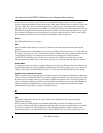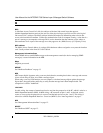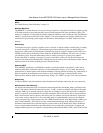
User Manual for the NETGEAR 7300 Series Layer 3 Managed Switch Software
Glossary C-11
202-10009-01_060204
L
LAN
See “Local Area Network” on page 11.
LDAP
See “Lightweight Directory Access Protocol” on page 11.
Lightweight Directory Access Protocol
A set of protocols for accessing information directories. LDAP is based on the standards contained within
the X.500 standard, but is significantly simpler. Unlike X.500, LDAP supports TCP/IP, which is necessary
for any type of Internet access. Although not yet widely implemented, LDAP should eventually make it
possible for almost any application running on virtually any computer platform to obtain directory
information, such as e-mail addresses and public keys. Because LDAP is an open protocol, applications
need not worry about the type of server hosting the directory.
Learning
The bridge examines the Layer 2 source addresses of every frame on the attached networks (called listening)
and then maintains a table, or cache, of which MAC addresses are attached to each of its ports.
Link-State
In routing protocols, the declared information about the available interfaces and available neighbors of a
router or network. The protocol's topological database is formed from the collected link-state declarations.
Load balancing
The ability to distribute traffic across various ports of a device, such as a switch, to provide efficient,
optimized traffic throughout the network.
Local Area Network
A communications network serving users within a limited area, such as one floor of a building. A LAN
typically connects multiple personal computers and shared network devices such as storage and printers.
Although many technologies exist to implement a LAN, Ethernet is the most common for connecting
personal computers and is limited to a distance of 1,500 feet. LANs can be connected together, but if
modems and telephones connect two or more LANs, the larger network constitutes what is called a WAN or
Wide Area Network.
Loop
An event that occurs when two network devices are connected by more than one path, thereby causing
packets to repeatedly cycle around the network and not reach their destination.


















